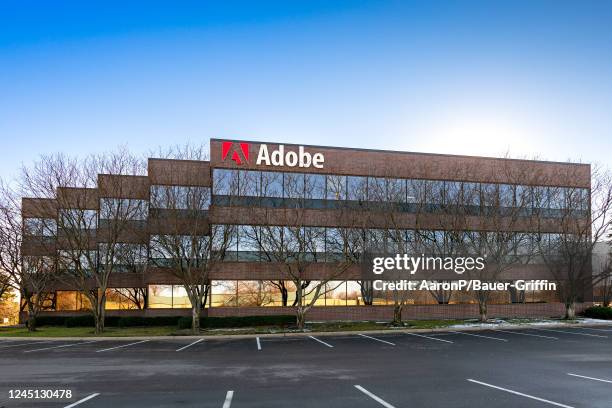Adobe Shares Slip 12% as Investors Seek More Clarity on AI Monetization

Adobe (NASDAQ:ADBE) saw its stock drop over 12% intra-day today after delivering a quarterly outlook that met expectations but failed to spark enthusiasm among investors. While the company’s latest financial results were broadly in line with Wall Street projections, analysts noted that they did little to strengthen the overall investment case for the stock.
A key focal point for Adobe remains its artificial intelligence (AI) strategy, which is seen as both a competitive advantage and a response to emerging threats from smaller, more agile rivals. While the company has integrated AI across its product suite, investors are eager for clearer guidance on when these efforts will translate into meaningful revenue growth.
Despite concerns about competition, some analysts argue that Adobe’s AI-driven revenue potential is being undervalued. Mizuho analysts believe that as AI monetization ramps up, its impact will become more visible in the second half of the year. They pointed to AI-related recurring revenue, which includes tools like Acrobat AI Assistant and GenStudio for Performance Marketing, reaching $125 million by the end of the first quarter. Company executives expect this figure to double by the end of fiscal 2025, reinforcing the long-term growth trajectory.
Adobe reported adjusted earnings per share of $5.08 on revenue of $5.71 billion, surpassing analysts' expectations of $4.97 EPS and $5.66 billion in revenue. For the upcoming quarter, the company forecasted revenue between $5.77 billion and $5.82 billion, aligning with consensus estimates. Its full-year guidance of $23.30 billion to $23.55 billion also remained steady, closely matching market expectations.
| Symbol | Price | %chg |
|---|---|---|
| 4338.HK | 1600 | 0 |
| CYBR.JK | 1340 | 0 |
| 377300.KS | 50700 | 0 |
| MSFT.NE | 35.54 | 0 |

Marjorie Taylor Greene Invests in Adobe Inc. (NASDAQ:ADBE)
- Adobe Inc. (NASDAQ:ADBE) stock presents a potential buying opportunity, being 38% cheaper amidst a 5.7% decline over the past month.
- The company is expected to announce strong earnings, with a predicted 12.06% year-over-year growth in earnings per share and an 8.85% increase in quarterly revenue.
- Despite recent declines, Adobe's stock has shown resilience with a 3.53% rise, trading at $355.53, and maintaining a significant market capitalization of approximately $148.83 billion.
On October 15, 2025, Marjorie Taylor Greene made a purchase transaction involving shares of Adobe Inc. (NASDAQ:ADBE). The transaction amount ranged between $1,001 and $15,000. Adobe is a leading software company known for its creative and digital marketing solutions. It competes with other tech giants in the software industry, such as Microsoft and Salesforce.
Adobe has recently become a trending stock on Zacks.com, drawing significant attention. Despite a 5.7% decline in Adobe's stock over the past month, the Zacks S&P 500 composite rose by 1.2%. The Zacks Computer - Software industry, which includes Adobe, also faced a 2% loss during the same period. This highlights the importance of fundamental factors for long-term investment decisions.
Adobe's stock is currently 38% cheaper, presenting a potential buying opportunity. Known for its high margins, Adobe's discounted price makes it appealing for investors. The stock ended a recent trading session at $333.26, a 1.22% increase from the previous day's close, outperforming the S&P 500's 0.53% gain.
Investors are eagerly awaiting Adobe's upcoming earnings report. The company is expected to announce earnings of $5.39 per share, a 12.06% year-over-year growth. The consensus estimate for quarterly revenue is $6.1 billion, an 8.85% increase from the same period last year. For the entire year, earnings are predicted to be $20.77 per share with revenue of $23.67 billion.
Adobe's stock is currently trading at $355.53, reflecting a 3.53% rise. The stock's price ranged from $343.32 to $357.70 during the day. Over the past year, Adobe's stock has reached a high of $557.90 and a low of $327.50. The company's market capitalization is approximately $148.83 billion, with a trading volume of 2,161,433 shares.

Adobe Inc. (NASDAQ: ADBE) Surpasses Earnings Expectations
- Adobe Inc. (NASDAQ:ADBE) reported an EPS of $5.31, beating the estimated $5.17, and revenue of $5.99 billion, surpassing forecasts.
- The company's stock price increased by 6% following the announcement of its third-quarter results, driven by strong financial performance and growth in demand for its design software and AI tools.
- Adobe raises its fiscal 2025 revenue and profit forecasts, with an optimistic outlook for its digital media business, projecting an 11.3% growth for the fiscal year.
Adobe Inc. (NASDAQ:ADBE) is a leading software company known for its creative and digital marketing solutions. The company offers a wide range of products, including Adobe Photoshop, Illustrator, and Acrobat, which are widely used by professionals and businesses worldwide. Adobe competes with other tech giants like Microsoft and Salesforce in the digital media and marketing space.
On September 11, 2025, Adobe reported its earnings, showcasing an impressive performance. The company achieved an earnings per share (EPS) of $5.31, surpassing the estimated $5.17. Additionally, Adobe's revenue reached approximately $5.99 billion, exceeding the forecasted $5.91 billion. This strong financial performance has been a key driver in the recent surge of Adobe's stock price.
Adobe's shares experienced a 6% increase following the release of its third-quarter results, as highlighted by CNBC's MacKenzie Sigalos. Looking ahead, Adobe has increased its fiscal 2025 revenue and profit forecasts, indicating a positive outlook. The company projects fourth-quarter EPS to be between $5.35 and $5.40, surpassing the average analyst estimate of $5.34. Revenue for the fourth quarter is anticipated to range from $6.08 billion to $6.13 billion, aligning with analysts' expectations.
Adobe's digital media business is expected to grow by 11.3% for the fiscal year, up from a previous estimate of 11%. For the fourth quarter, digital media revenue is projected to be between $4.56 billion and $4.51 billion, exceeding the average estimate of $4.51 billion. These positive projections have contributed to the recent spike in Adobe's stock price, despite a challenging year where shares have fallen by 21%.

Adobe Inc. (NASDAQ: ADBE) Quarterly Earnings Preview
- Adobe Inc. (NASDAQ:ADBE) is expected to report a 5.1% increase in Q3 earnings with a 6% rise in revenues.
- The company's price-to-earnings (P/E) ratio is approximately 22.56, and its price-to-sales ratio stands at about 6.73, indicating strong market confidence.
- Adobe's debt-to-equity ratio is approximately 0.57, suggesting a moderate level of debt, with a current ratio of about 0.99, highlighting financial stability.
Adobe Inc. (NASDAQ:ADBE) is a leading software company known for its creative and digital marketing solutions. As it prepares to release its quarterly earnings on September 11, 2025, analysts are keenly observing its performance. The expected earnings per share (EPS) is $5.17, with projected revenue of approximately $5.91 billion. Adobe's consistent growth in the technology sector positions it as a key player among its competitors.
Adobe is anticipated to report a 5.1% increase in Q3 earnings compared to the same period last year, driven by a 6% rise in revenues. This growth follows significant earnings increases of 12.4% and 12.3% in the first and second quarters of 2025, respectively. The technology sector's robust growth, with positive revisions in earnings estimates since late April, supports Adobe's favorable outlook.
Adobe's financial metrics provide insights into its market valuation. The company's price-to-earnings (P/E) ratio is approximately 22.56, indicating how the market values its earnings. Its price-to-sales ratio stands at about 6.73, reflecting the market's valuation of its revenue. These figures suggest a strong market confidence in Adobe's financial health and future prospects.
The enterprise value to sales ratio of around 6.80 and the enterprise value to operating cash flow ratio of approximately 15.99 offer further insights into Adobe's valuation relative to sales and cash flow. The earnings yield for Adobe is about 4.43%, providing a perspective on the return on investment. These metrics highlight Adobe's solid financial foundation and its ability to generate returns for investors.
Adobe's debt-to-equity ratio is approximately 0.57, suggesting a moderate level of debt relative to equity. This indicates a balanced approach to leveraging debt for growth. Additionally, Adobe has a current ratio of about 0.99, indicating its ability to cover short-term liabilities with short-term assets. This financial stability positions Adobe well for continued growth and success in the competitive technology sector.

Adobe Beats Q2 Amid Strong AI Momentum, But Stocks Drops 5%
Adobe (NASDAQ:ADBE) has turned in a stronger-than-expected performance for its fiscal second quarter, prompting the software powerhouse to lift its full-year financial projections. Riding the continued surge in demand for AI-driven creative tools, the company’s core digital media division delivered robust gains.
Despite this solid showing, investor enthusiasm was muted. Adobe's stock dropped more than 5% intra-day today, as some analysts suggested the revised outlook, while positive, didn’t quite match the upbeat momentum seen from other tech peers like Oracle earlier in the week.
Looking ahead to the remainder of its fiscal year, Adobe now anticipates adjusted earnings per share to range from $20.50 to $20.70, with revenue expected to land between $23.50 billion and $23.60 billion. This marks a modest bump from its earlier forecast, which placed EPS at $20.20 to $20.50 and revenue between $23.30 billion and $23.55 billion.
The company’s digital media arm, a key growth engine, is also expected to contribute more than previously projected. New estimates put segment revenue between $17.45 billion and $17.50 billion, edging up from the earlier range of $17.25 billion to $17.40 billion.
As for the upcoming third quarter, Adobe expects adjusted earnings per share to fall between $5.15 and $5.20, with revenue reaching up to $5.925 billion. Both figures surpass current Wall Street expectations, which hovered at $5.11 for earnings and $5.88 billion in revenue.
In the second quarter, Adobe posted $5.87 billion in revenue, beating analyst predictions of $5.8 billion and reaffirming its steady trajectory amid the ongoing AI boom.

Adobe Inc. (NASDAQ:ADBE) Quarterly Earnings Preview
- Adobe Inc. (NASDAQ:ADBE) is expected to report an EPS of $4.96 and revenue of $5.8 billion for the upcoming quarter, indicating significant year-over-year growth.
- The stock has declined nearly 30% from its 52-week high, partly due to concerns over AI disruption and regulatory challenges in acquiring Figma.
- Adobe's financial health remains strong with a P/E ratio of 26.87, a price-to-sales ratio of 8.05, and a debt-to-equity ratio of 0.03.
Adobe Inc. (NASDAQ:ADBE), a leader in creative and digital marketing solutions, is gearing up for its quarterly earnings release on June 12, 2025. Analysts have set the bar with expectations for an earnings per share (EPS) of $4.96 and revenue of approximately $5.8 billion. This represents a notable increase from the previous year, with EPS up by 10.7% and revenue growing by 9%.
Despite these optimistic projections, Adobe's stock has experienced a downturn, currently sitting nearly 30% below its 52-week high of $587 per share. The potential impact of AI disruption on Adobe's core creative software suite has been a significant concern, driving the stock's decline. Nevertheless, Adobe is proactively incorporating AI into its digital experience solutions to mitigate these fears.
The company's efforts to acquire Figma, a collaborative design platform, have encountered regulatory obstacles, further influencing its stock performance. Investors are keenly awaiting the upcoming earnings report and the impact of May's Consumer Price Index (CPI) data on market trends. Historically, Adobe's stock has shown a tendency to react negatively to earnings announcements, with a median drop of 7.4% in 70% of cases over the past five years.
Adobe's financial metrics shed light on its market standing. The company boasts a P/E ratio of approximately 26.87, signaling investor confidence in its future earnings. Its price-to-sales ratio stands at about 8.05, indicating how the market values its revenue. With a debt-to-equity ratio of 0.03, Adobe demonstrates a prudent approach to leveraging, maintaining a current ratio of 1.18 to comfortably cover its short-term liabilities.

RBC Reaffirms Outperform on Adobe Ahead of Q2 Earnings
RBC Capital reiterated its Outperform rating on Adobe (NASDAQ:ADBE) with a $480 price target, expressing optimism ahead of the company’s Q2 earnings report scheduled for June 12.
While Adobe’s stock has lagged behind its large-cap tech peers, RBC noted a shift toward more constructive investor sentiment at current valuation levels. The firm believes upcoming results should be solid, but attention will remain centered on how effectively Adobe navigates the evolving competitive landscape shaped by generative AI.
Key to improving sentiment, according to RBC, will be Adobe’s progress on monetizing generative AI. Initiatives such as tiered pricing and generative credit models in video and creative workflows may offer greater transparency and momentum in this emerging revenue stream.

Adobe Inc. (NASDAQ:ADBE) Outperforms in ROIC to WACC Ratio Among Tech Giants
Adobe Inc. (NASDAQ:ADBE) is a leading software company known for its creative and digital marketing solutions. It offers products like Adobe Photoshop, Adobe Illustrator, and Adobe Acrobat, which are widely used by professionals and businesses worldwide.
Adobe competes with other tech giants such as Salesforce, PayPal, Mastercard, NVIDIA, and Shopify in various segments of the technology industry. Adobe's Return on Invested Capital (ROIC) is 31.77%, which is significantly higher than its Weighted Average Cost of Capital (WACC) of 11.23%. This results in a ROIC to WACC ratio of 2.83, indicating that Adobe efficiently generates returns well above its cost of capital. This efficiency is a testament to Adobe's strong market position and effective use of its resources.
In comparison, Salesforce (CRM) has a ROIC of 7.95% and a WACC of 10.58%, resulting in a ROIC to WACC ratio of 0.75. This suggests that Salesforce is not generating returns above its cost of capital as effectively as Adobe. Similarly, Shopify (SHOP) has a ROIC of 9.08% and a WACC of 16.66%, with a ROIC to WACC ratio of 0.55, indicating less efficiency in generating returns.
On the other hand, NVIDIA (NVDA) outperforms with a ROIC of 75.29% and a WACC of 14.12%, leading to a ROIC to WACC ratio of 5.33. This makes NVIDIA the most efficient among the peers in generating returns relative to its cost of capital. Mastercard (MA) also shows strong performance with a ROIC of 43.98% and a WACC of 8.99%, resulting in a ROIC to WACC ratio of 4.89.
PayPal (PYPL) has a ROIC of 13.24% and a WACC of 10.39%, with a ROIC to WACC ratio of 1.27. While PayPal is generating returns above its cost of capital, it is not as efficient as Adobe or NVIDIA. Overall, Adobe's strong ROIC to WACC ratio highlights its ability to effectively utilize its capital to generate substantial returns, maintaining its competitive edge in the industry.







